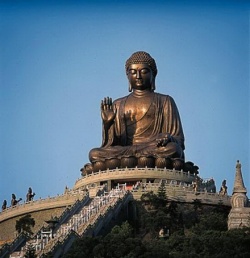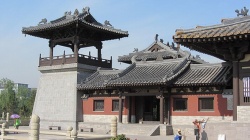The Buddha and Buddhism: China
Although there are reports of Buddhists in China as early as the 3rd century BC, Buddhism was not actively propagated in that country until the early centuries of the Common era. Tradition has it that Buddhism was introduced after the Han emperor Ming Ti (reigned AD 57/58-75/76) had a dream of a flying golden deity that was interpreted as a vision of The Buddha. Accordingly, the emperor dispatched emissaries to India who subsequently returned to China with The Sutra in Forty-Two Sections, which was deposited in a temple outside the capital of Lo-yang. In actuality, Buddhism entered China gradually, first primarily through Central Asia and, later, by way of the trade routes around and through Southeast Asia.
The early centuries.
The Buddhism that first became popular in China during the Han dynasty was deeply coloured with magical practices, making it compatible with popular Chinese Taoism (a combination of folk beliefs and practices and philosophy). Instead of the doctrine of no-self, early Chinese Buddhists taught the indestructibility of the soul. Nirvana became a kind of immortality. They also taught the theory of Karma, the values of charity and compassion, and the need to suppress the passions. Until the end of the Han dynasty, there was a virtual symbiosis between Taoism and Buddhism and a common propagation of the means for attaining immortality through various ascetic practices. It was widely believed that Lao-tzu, the founder of Taoism, had been reborn in India as The Buddha. Many Chinese emperors worshiped Lao-tzu and The Buddha on the same altar. The first translations of Buddhist sutras into Chinese--namely those dealing with such topics as breath control and mystical concentration--utilized a Taoist vocabulary to make the Buddhist faith intelligible to the Chinese.
After the Han period, in the north of China, Buddhist monks were often used by non-Chinese emperors for their political-military counsel as well as for their skill in magic. At the same time, in the south, Buddhism began to penetrate the philosophical and literary circles of the gentry. One of the most important contributions to the growth of Buddhism in China during this period was the work of translation. The most important of the early translators was the learned Monk Kumarajiva, who, before he was brought to the Chinese court in AD 401, had studied the Hindu Vedas, the occult sciences, and astronomy, as well as the Hinayana and Mahayana sutras.
During the 5th and 6th centuries AD Buddhist schools from India became established, and new, specifically Chinese schools began to form. Buddhism was becoming a powerful intellectual force in China, monastic establishments were proliferating, and Buddhism was becoming well-established among the peasantry. Thus, it is not surprising that, when the Sui dynasty (581-618) established its rule over a reunified China, Buddhism flourished as a state religion.
Developments during the T'ang dynasty (618-907).
The golden age of Buddhism in China occurred during the T'ang dynasty. Though the T'ang emperors were usually Taoists themselves, they tended to favour Buddhism, which had become extremely popular. Under the T'ang the government extended its control over the monasteries and the ordination and legal status of monks. From this time forward, the Chinese Monk styled himself simply ch'en, or "a subject."
During this period several Chinese schools developed their own distinctive approaches. Some of them produced comprehensive systematizations of the vast body of Buddhist texts and teachings. There was a great expansion in the number of Buddhist monasteries and the amount of land they owned. It was also during this period that many scholars made pilgrimages to India, heroic journeys that greatly enriched Buddhism in China, both by the texts that were acquired and by the intellectual and spiritual inspiration that was brought from India. Buddhism was never able to replace its Taoist and Confucian rivals, however, and in 845 the emperor Wu-tsung began a major persecution. According to records, 4,600 Buddhist temples and 40,000 shrines were destroyed, and 260,500 monks and nuns were forced to return to lay life.
Buddhism after the T'ang.
Buddhism in China never recovered completely from the great persecution of 845. It did maintain much of its heritage, however, and it continued to play a significant role in the religious life of China. On the one hand, Buddhism retained its identity as Buddhism and generated new forms through which it was expressed. These included texts such as the yü lu, or "recorded sayings," of famous teachers that were oriented primarily toward monks, as well as more literary creations such as the Journey to the West (written in the 16th century) and The Dream of the Red Chamber (18th century). On the other hand, Buddhism coalesced with the Confucian- Neo-Confucian and Taoist traditions to form a complex multi-religious ethos within which all three traditions were more or less comfortably encompassed.
Among the various schools the two that retained the greatest vitality were the Ch'an school (better known in the West by its Japanese name, Zen) which was noted for its emphasis on meditation, and the Pure land tradition, which emphasized Buddhist devotion. The former school exerted the greatest influence among the cultured elite. It did so through various media, including the arts. For example, Ch'an artists during the Sung dynasty (960-1279) had a decisive impact on Chinese landscape painting. Artists used images of flowers, rivers, and trees, executed with sudden, deft strokes, to evoke an insight into the flux and emptiness of all reality. The Pure land tradition exerted a greater influence on the population as a whole and was sometimes associated with secret societies and peasant uprisings. But the two seemingly disparate traditions were often very closely linked. In addition, they were mixed with other Buddhist elements such as the so-called "masses for the dead" that had originally been popularized by the practitioners of Esoteric Buddhism.
During the early decades of the 20th century, China experienced a Buddhist reform movement aimed at revitalizing the Chinese Buddhist tradition and adapting Buddhist teachings and institutions to modern conditions. However, the disruptions caused by the Sino-Japanese War and the subsequent establishment of a communist government have not been helpful to the Buddhist cause. The Buddhist community was the victim of severe repression during the Cultural Revolution (1966-69). Since 1976 the Chinese government has pursued a more tolerant policy, but the extent of continuing Buddhist vitality is difficult to determine.

